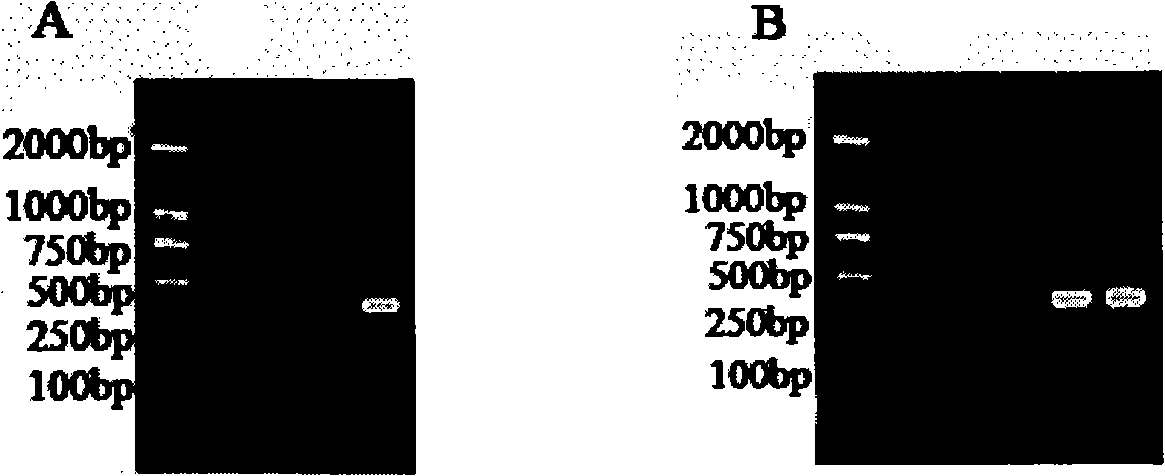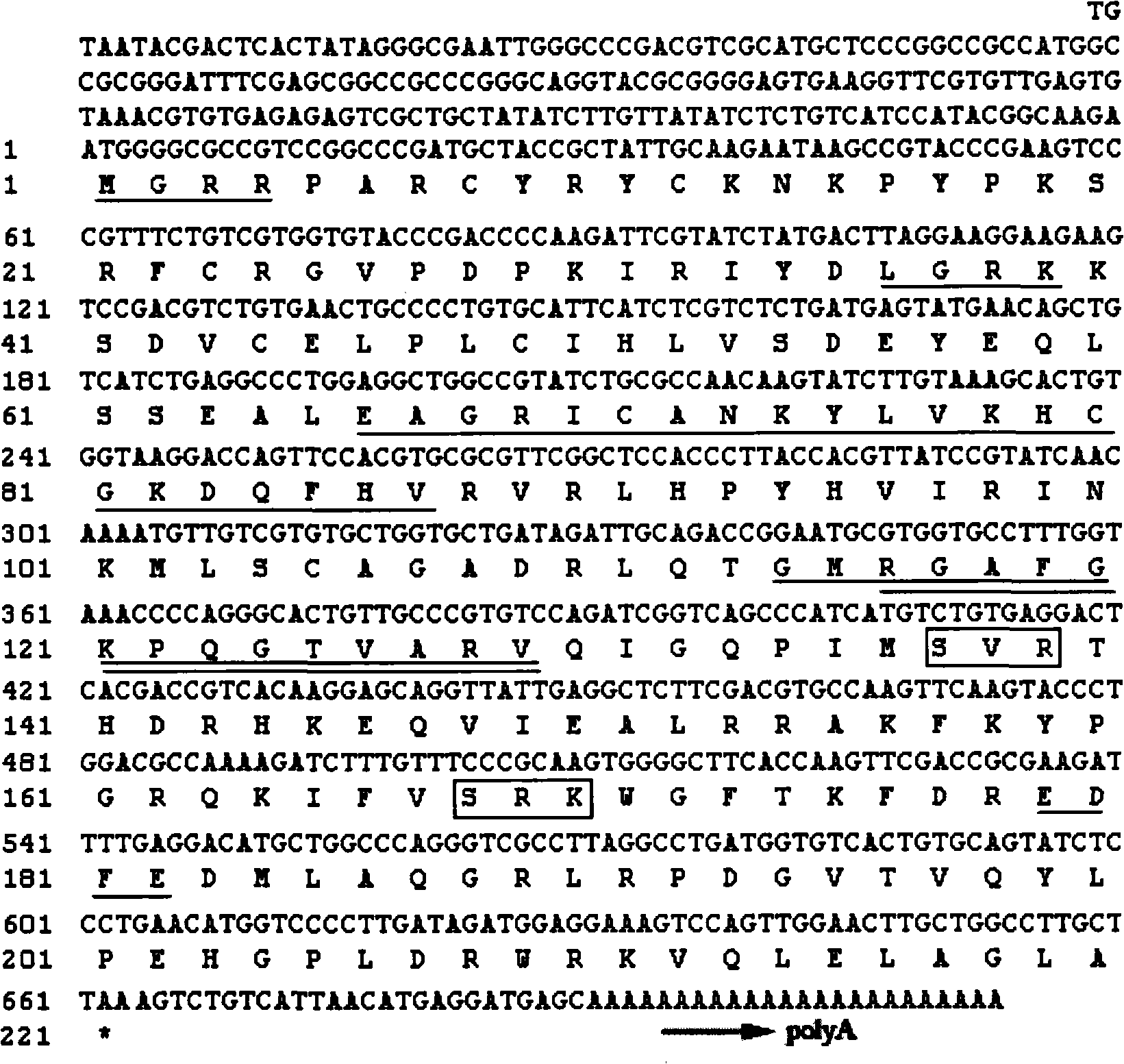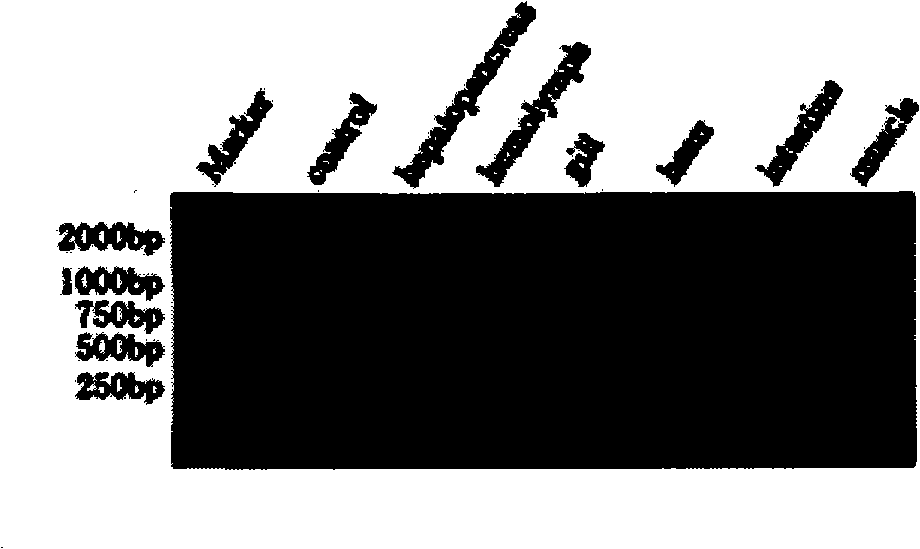Prawn QM protein for regulating phenol oxidizing enzymes (PO) activity by interactively acting with hemocyanin
A technology of hemocyanin and prawns, applied in medical raw materials and antiviral agents derived from Ginkgo biloba, can solve problems such as decreased yeast protein synthesis, abnormal cytoskeleton, growth and division arrest, etc.
- Summary
- Abstract
- Description
- Claims
- Application Information
AI Technical Summary
Problems solved by technology
Method used
Image
Examples
Embodiment 1
[0035] Structure of the QM gene
[0036] According to the results of suppression subtractive hybridization (SSH) in our laboratory, a gene fragment with high homology to QM was up-regulated in the disease-resistant shrimp. In order to study the function of the QM gene, the RACE technique ( figure 1 ), obtained the full-length cDNA sequence of QM gene, GenBank accession No.EU004069 ( figure 2 ). Since this gene comes from Peneaus japonicus, we named it PjQM according to the source. After sequencing the obtained DNA fragment of about 1000bp, homology comparison analysis found that the homology of shrimp QM protein with human, mouse, Drosophila and brewer's yeast was 76.23%, 76.82%, 78.64% and 62.44%, respectively.
[0037] See attached figure 1 RACE analysis to obtain QM cDNA A: 5'RACE product, B: Colony PCR
[0038] After analyzing the cDNA, it was found that the PjQM gene contained an open reading frame (open reading frame, ORF) with a length of 663bp, which was predicte...
Embodiment 2
[0041] Transcription and expression analysis of 2PjQM gene in shrimp
[0042] After extracting total RNA from the muscle, heart, hepatopancreas, digestive tract, blood, and gills of Penaeus japonicus, reverse transcription was performed using OligdT(18) as a reverse transcription primer, and the cDNA of each tissue was used as a template to amplify the PjQM gene , the results showed that the PjQM gene could be amplified in muscle, heart, hepatopancreas, digestive tract, blood and gills, indicating that PjQM was transcribed in every detected tissue ( image 3 ), without tissue specificity at the transcriptional level.
[0043] attached image 3 RT-PCR analysis of PjQM gene transcription tissue specificity, in which
[0044] 1: DNA marker; 2: Negative control; 3-8: Muscle, heart, hepatopancreas, digestive tract, blood, gill, respectively.
[0045] Muscle, heart, hepatopancreas, digestive tract, blood, gills and other tissues of Penaeus japonicus were homogenized, then SDS-PAG...
Embodiment 3
[0048] 1. The role of QM protein in shrimp immunity
[0049] 3.1 The effect of virus stimulation on the expression of QM in shrimp
[0050]Penaeus japonicus was injected with WSSV, and the total RNA of the hepatopancreas was extracted at 0h, 4h, 8h, 12h, 24h, 48h and 72h after infection, and the cDNA was reverse-transcribed with Olig(dT) as a primer. Using 18S RNA as a control, the real-time PCR method was used to study the changes in the transcriptional level of PjQM gene after the shrimp was infected with WSSV virus. It was found that the transcription of PjQM was up-regulated 4 hours after being infected by the virus, and its expression level was about 150% of that of normal prawns after 72 hours of infection ( Figure 5 ). At the same time, the results of Real-time PCR showed that in the disease-resistant shrimp, the expression of PjQM gene was 180% of the normal level ( Figure 5 ), showing a significantly up-regulated expression. At the same time, using the Weste...
PUM
| Property | Measurement | Unit |
|---|---|---|
| Theoretical molecular weight | aaaaa | aaaaa |
Abstract
Description
Claims
Application Information
 Login to View More
Login to View More - R&D
- Intellectual Property
- Life Sciences
- Materials
- Tech Scout
- Unparalleled Data Quality
- Higher Quality Content
- 60% Fewer Hallucinations
Browse by: Latest US Patents, China's latest patents, Technical Efficacy Thesaurus, Application Domain, Technology Topic, Popular Technical Reports.
© 2025 PatSnap. All rights reserved.Legal|Privacy policy|Modern Slavery Act Transparency Statement|Sitemap|About US| Contact US: help@patsnap.com



